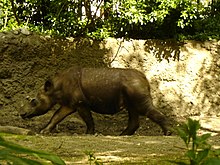Dicerorhinus
| Dicerorhinus Temporal range:
| |
|---|---|

| |
| Rapunzel, a Sumatran Rhino in the Bronx Zoo
| |
| Scientific classification | |
| Domain: | Eukaryota |
| Kingdom: | Animalia |
| Phylum: | Chordata |
| Class: | Mammalia |
| Order: | Perissodactyla |
| Family: | Rhinocerotidae |
| Tribe: | Dicerorhinini
|
| Genus: | Dicerorhinus Gloger , 1841
|
| Species | |
| |
Dicerorhinus (Greek: "two" (dio), "horn" (keratos), "nose" (rhinos)
Taxonomy
Species provisionally considered valid include:
- †Dicerorhinus fusuiensis[4][5] originally described as Rhinoceros fusuiensis[6] Early Pleistocene, South China.
- †Dicerorhinus gwebinensis Zin-Maung-Maung-Thein et al., 2008 Known from a skull of Pliocene-Early Pleistocene age found in Myanmar.[7] Some authors have considered the skull not distinguishable from that of D. sumatrensis.[8]
Historically, Dicerorhinus was a wastebasket taxon. Revisions by several authors over the years have removed many species:
Transferred to Stephanorhinus[3]
- Dicerorhinus merckii
- Dicerorhinus hemitoechus
- Dicerorhinus etruscus
- Dicerorhinus yunchuchenensis
- Dicerorhinus jeanvireti
- Dicerorhinus choukoutienensis (synonym of Merck's rhinoceros)
- Dicerorhinus orientalis (synonym of Merck's rhinoceros)
- Dicerorhinus nipponicus[9]
- Dicerorhinus megarhinus
- Dicerorhinus schleiermacheri
- Dicerorhinus ringstroemi
Transferred to Caementodon
- Dicerorhinus caucasicus[10]
Transferred to Lartetotherium
- Dicerorhinus sansaniensis
- Dicerorhinus cixianensis Chen and Wu, 1976[11]
Transferred to Rusingaceros
- Dicerorhinus leakeyi
Placement of the Sumatran rhinoceros among recent and subfossil rhinoceros species based on nuclear genomes (Liu, 2021)[12]
| |||||||||||||||||||||||||||||||||||||||||||
| |||||||||||||||||||||||||||||||||||||||||||||||||||||||||||||||||||||||||||||||||||||||||||||||||||||||||||||||||||||||||||||||||||||||||||||||||||||||||||||||||||
References
- ^ "Glossary. American Museum of Natural History". Archived from the original on 20 November 2021.
- PMID 29249659.
- ^ .
- .
- ISSN 0267-8179.
- .
- .
- ISSN 1000-9515.
- S2CID 145930245.
- S2CID 86800130.
- ^ Deng, T.; Li, S., 2023. Restudy of Rhinocerotini fossils from the Miocene Jiulongkou fauna of China. Vertebrata PalAsiatica 61: 198-211 - DOI: 10.19615/j.cnki.2096-9899.230630
- S2CID 237273079.
- ISSN 0267-8179.
- Groves, Colin P., and Fred Kurt (1972). "Dicerorhinus sumatrensis". Mammalian Species (21): 1–6.
- "A new species of Dicerorhinus (Rhinocerotidae) from the Plio-Pleistocene of Myanmar" Archived 2020-10-11 at the Wayback Machine
